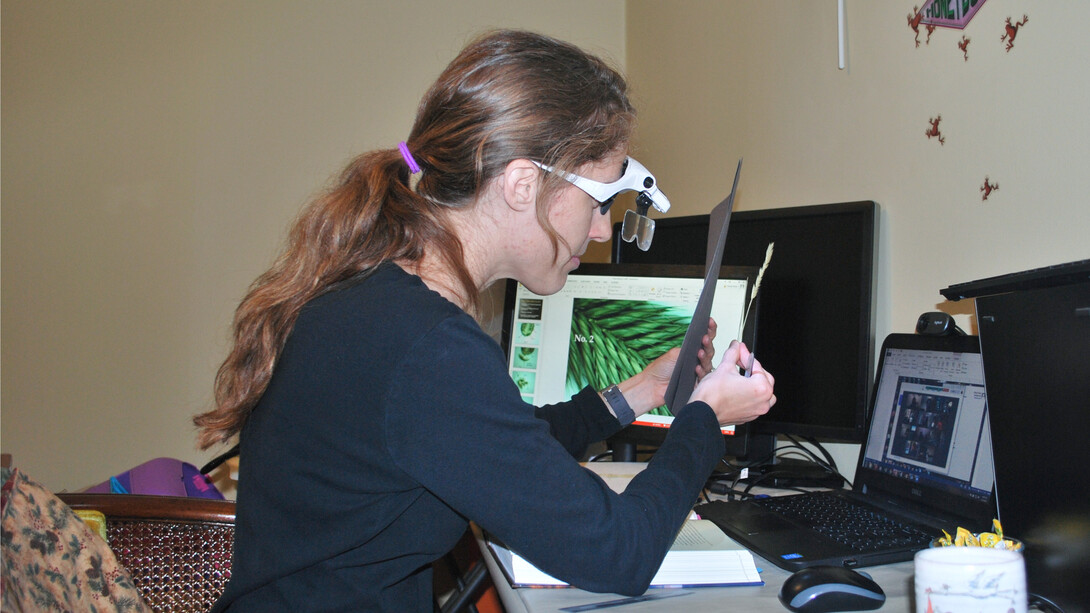
Cheryl Dunn had to completely rethink how she was going to teach Agronomy 442/842 Wildland Plants when the fall 2020 course shifted online due to COVID-19.
The course is a comprehensive study of plants that are important in natural resource management and involves a heavy emphasis on intensive lab and field study. The class meets twice a week to learn about and identify more than 200 species of plants from the Great Plains and the tall grass prairie all the way to the California Annual Grasslands. The class is hands on as students use microscopes, dissecting tools, mounted herbarium specimens, live plants and field trips to local prairies to learn how to correctly identify each plant.
Dunn, a research manager and herbarium curator in the Department of Agronomy and Horticulture, is in her 11th-year teaching three plant classes, both in person and online and isn’t a newbie with remote delivery. However, this is her first-time teaching Wildland Plants online — and she hadn’t planned on breaking new ground.
“No one has ever focused on teaching grass identification online to the extent that this course requires,” Dunn said.
Throughout the summer Dunn collected ideas from colleagues on how to teach such an intensive hands-on lab course remotely and what equipment would allow students to work with the specimens to see the tiny details necessary for species identification. She also collected grass specimens for packets that were sent to each student to provide the hands-on experience of learning to identify a plant species using a dichotomous key. This key is a tool that allows the user to determine the plant identity through a series of choices that result in the correct name of the specimen.
“There are inherent challenges to seeing the fine detail in the grass specimens. My hope is that they will gain invaluable experience at where to look and how to use a dichotomous key,” Dunn said.
Along with the usual book requirement, students had to purchase a magnification instrument to substitute for a microscope, the usual piece of equipment used to see a specimen’s details. Fortunately, tools like this are readily available. Students chose either a macro lens adapted for their phones or an optivisor, a head mounted magnifier.
“I love the suggested equipment for this class, which includes the optivisor, dissecting kit and smartphone macro lens attachment. I can see myself utilizing these tools for future endeavors,” said Carina Olivetti, a senior environmental studies major.
Many herbaria, institutions housing a systematically arranged collection of dried plants, have digitized their entire collections. With access to the department’s herbarium unavailable, these images are utilized for the mounted specimens that students are unable to access from the university’s collection.
Each week Dunn holds class using Zoom. Students work at home on the same assignments given in previous years as if they were in the classroom. When they have questions, Dunn is available to help and guide them.
“I find the same challenges from in-person as I do online. There are the same questions and the same struggles,” Dunn said. “I think that is one of the more surprising aspects is that so far it is very similar, Dunn said.
The pandemic has challenged Dunn to develop new ways for students to learn, have some fun and give them a break from the computer.
The biggest change Dunn made this semester has been the addition of outdoor observations. She specifically asks students to show what they know by taking pictures of plants they have identified. These pictures must include a talisman specific to each student to assure the photos are original and belong to that student. Students have been very creative in selecting their talisman using rings, necklaces and little toys. A tiny doll with a hat and wings glued to a paper clip and named Shirley belongs to Olivetti.
“I would like to think that the outdoor time allows them to take a break from the screen and just provide them with an appreciation of their surroundings and some good nature therapy,” Dunn said.
She has also added group activities with the hope students connect with each other regardless of whether they ever meet in person. She introduced a fun activity related to toxic plants this year with some students posing as patients with various symptoms and other students posing as doctors who have to diagnose what plant the patients encountered or ingested.
“Dunn is determined to challenge us on a variety of levels. Even with COVID-19, Dunn’s hands-on lab virtual experience has been beneficial to learning the plants and the language of plant identification,” Olivetti said.
Dunn also relies on her teaching assistant, Jacob Harvey, senior fisheries and wildlife major, to provide tours of Nine Mile Prairie and assist with plant identification when students venture out to explore.
Being in the classroom right beside her students figuring something out through the lens of a microscope is what Dunn misses the most. But this experience has taught her several important lessons.
“We as instructors can share information and ideas and make teaching easier and better for everyone. We also have to always remain curious and creative and push ourselves to unknown limits in order to accomplish the task that appears impossible. It might not be what we want, but we can do it and do it well,” Dunn said.
Dunn is a member of the department’s range, pasture and forages group and spends her time teaching, conducting research, and curating and managing the herbarium. She is the coach for the Nebraska’s Plant Identification Team. Dunn has co-authored three books including “Grasses of the Great Plains,” “North American Wildland Plants” and “Weeds of the Great Plains.” She has also co-authored three Extension publications including “Grasses of Nebraska,” “Forbs and Shrubs of Nebraska” and “Toxic Plants to Livestock.”
Agronomy 496 An Introduction to Plant Identification, a one credit course taught by Dunn, will be offered in the fall three-week session.







